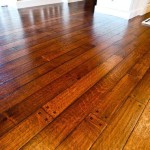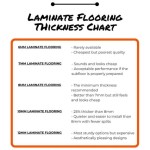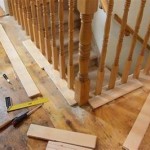Fixing Holes In Vinyl Flooring: A Comprehensive Guide
Vinyl flooring, prized for its durability, affordability, and water resistance, is a popular choice for residential and commercial spaces. However, even the most robust vinyl flooring is susceptible to damage, including holes. These holes can be caused by dropped objects, sharp items, or even general wear and tear over time. Ignoring these holes can lead to further damage, such as moisture seeping beneath the flooring, potentially causing mold growth and structural issues. Repairing these holes promptly is crucial for maintaining the integrity and appearance of the flooring.
This article provides a detailed guide on how to effectively repair holes in vinyl flooring, covering various methods depending on the size and severity of the damage. It also discusses the necessary tools and materials, along with step-by-step instructions to ensure a successful repair.
Assessing the Damage and Gathering Supplies
Before commencing any repair, a thorough assessment of the damage is necessary. This involves identifying the size, depth, and location of the hole. The type of vinyl flooring (sheet vinyl, tile, or plank) and the severity of the damage will dictate the appropriate repair method and the materials required. Small punctures or minor scratches may only require a vinyl repair kit, while larger holes might necessitate replacing a section of the flooring or using a patching compound.
The following lists the basic supplies needed for most vinyl floor repairs. Additional items may be required depending on the chosen repair method.
*Utility Knife:
A sharp utility knife is essential for cutting and trimming vinyl flooring. Ensure the blade is new and sharp for clean, precise cuts. Safety is paramount; always use the knife with caution and wear cut-resistant gloves. *Measuring Tape:
Accurate measurements are crucial for a seamless repair. A measuring tape ensures that the patch or replacement piece is the correct size. *Straight Edge:
A metal ruler or straight edge provides a guide for making straight cuts with the utility knife. This is particularly important when cutting a patch from a new piece of vinyl flooring. *Putty Knife or Scraper:
A putty knife or scraper is used for applying patching compound, removing old adhesive, and smoothing out surfaces. *Vinyl Repair Kit:
For minor holes and scratches, a vinyl repair kit with a selection of colored fillers can be used to blend the repair with the existing flooring. *Patching Compound:
For larger holes, a vinyl patching compound is necessary to fill the void and create a level surface. *Vinyl Flooring Adhesive:
Depending on the repair method, vinyl flooring adhesive may be required to secure the patch or replacement piece. Choose an adhesive specifically designed for vinyl flooring to ensure a strong and lasting bond. *Heat Gun or Hair Dryer:
A heat gun or hair dryer can be used to soften the vinyl flooring, making it easier to cut and manipulate. Use caution when applying heat to avoid damaging the flooring. *Cleaning Supplies:
Before starting the repair, the area around the hole should be thoroughly cleaned with a mild detergent and water. This removes dirt, debris, and grease, ensuring a proper bond for adhesives and patching compounds. *Safety Glasses and Gloves:
Safety glasses protect the eyes from debris, and gloves protect the hands from sharp tools and chemicals.Repairing Small Holes and Scratches with a Vinyl Repair Kit
For small holes and scratches, a vinyl repair kit offers a simple and effective solution. These kits typically include a range of colored fillers that can be mixed and matched to match the existing flooring's color. The repair process involves cleaning the damaged area, applying the filler, and smoothing the surface to create a seamless blend.
The following steps detail the process:
1.Clean the Area:
Thoroughly clean the area around the hole or scratch with a mild detergent and water. Remove any loose debris or dirt. Allow the area to dry completely before proceeding. 2.Select the Appropriate Filler Color:
Choose the filler color that best matches the existing vinyl flooring. If necessary, mix several colors to achieve a perfect match. Test the color on an inconspicuous area of the flooring to ensure it blends seamlessly. 3.Apply the Filler:
Use a putty knife to apply the filler to the hole or scratch. Overfill the area slightly to allow for shrinkage during the drying process. 4.Smooth the Surface:
Use the putty knife to smooth the surface of the filler, ensuring it is level with the surrounding flooring. Remove any excess filler with a clean cloth. 5.Allow to Dry:
Allow the filler to dry completely according to the manufacturer's instructions. This may take several hours or even overnight. 6.Sand Lightly (If Necessary):
If the filler has shrunk or is not perfectly level with the surrounding flooring, lightly sand the surface with fine-grit sandpaper. Be careful not to scratch the surrounding flooring. 7.Clean and Polish:
Clean the repaired area with a damp cloth and polish with a vinyl floor cleaner to restore the shine and blend the repair with the rest of the flooring.Patching Larger Holes with a Replacement Piece
Larger holes in vinyl flooring require a more extensive repair, typically involving replacing a section of the flooring with a new piece. This method is best suited for situations where the hole is too large to be effectively filled with patching compound or when the damage is extensive.
The following steps outline the process of patching a larger hole:
1.Locate a Replacement Piece:
The first step is to find a replacement piece of vinyl flooring that matches the existing flooring as closely as possible. If the original flooring is no longer available, try to find a similar pattern and color. An extra piece of the original material is ideal, if available from the initial installation. 2.Cut Out the Damaged Section:
Using a utility knife and a straight edge, carefully cut out the damaged section of the flooring. Make sure the cuts are clean and precise. Cut a square or rectangular shape around the hole to create a uniform opening. 3.Prepare the Subfloor:
Clean the subfloor beneath the hole to remove any debris or adhesive residue. The subfloor should be clean, smooth, and level to ensure a proper bond for the replacement piece. 4.Create a Template:
Place the cut-out section of flooring on top of the replacement piece and use it as a template to cut the new piece to the exact size and shape. Ensure the pattern aligns correctly with the surrounding flooring. 5.Apply Adhesive:
Apply vinyl flooring adhesive to the subfloor within the prepared opening. Use a notched trowel to spread the adhesive evenly. 6.Install the Replacement Piece:
Carefully place the replacement piece into the opening, aligning the edges with the surrounding flooring. Press the piece firmly into the adhesive to ensure a strong bond. 7.Roll the Patch:
Use a floor roller to apply pressure to the replacement piece, further securing it to the adhesive. This helps to eliminate air pockets and ensures a uniform bond. 8.Clean Up Excess Adhesive:
Wipe away any excess adhesive that squeezes out from the edges of the replacement piece with a damp cloth. 9.Allow to Dry:
Allow the adhesive to dry completely according to the manufacturer's instructions. This may take several hours or overnight. 10.Seam Sealing (If Necessary):
For sheet vinyl, seam sealing is often necessary to create a waterproof and seamless finish. Use a seam sealer specifically designed for vinyl flooring and follow the manufacturer's instructions carefully. Heat welding may be employed by professionals for an even stronger seam.Successfully patching a hole in vinyl flooring requires patience, precision, and the right tools and materials. By carefully following these steps, individuals can effectively repair damage and restore the appearance of their flooring. While this guide provides comprehensive instructions, consulting with a professional flooring installer may be beneficial for complex or extensive repairs.

How To Repair Vinyl Flooring Fixing Sc Bubbles More

Repairing Vinyl Flooring Diy Family Handyman

How To Repair Vinyl Flooring Fixing Sc Bubbles More

How To Repair Vinyl Flooring Fixing Sc Bubbles More

Repairing Vinyl Flooring Diy Family Handyman

Avoid Costly Mistakes Repairing Vinyl Plank Flooring Made Easy

How To Repair Vinyl Flooring Fixing Sc Bubbles More

Repair Vinyl Flooring Patch Damaged Diy

How To Repair Luxury Vinyl Plank Flooring The Palette Muse

Repair Hole In Damaged Hardwood Floor Slaughterbeck Floors Inc
Related Posts








